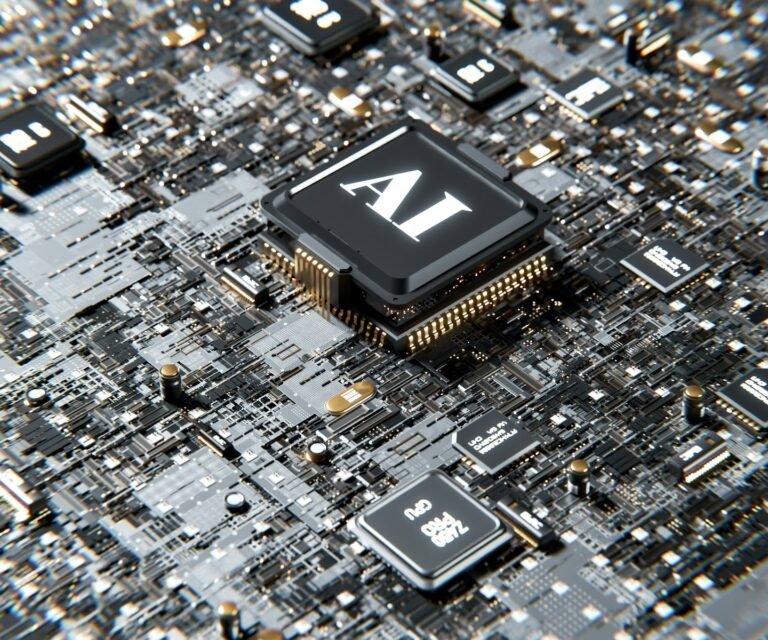Introduction: A Game-Changer in the Tech Industry
In recent months, the technology sector has witnessed a compelling shift, marked by Nvidia’s remarkable rise to prominence as the world’s largest company by market capitalization, eclipsing Apple. This transformative moment underscores not only Nvidia’s strategic positioning within the industry but also the burgeoning significance of artificial intelligence (AI) as a driver of economic and technological advancement. As Wall Street and investors increasingly focus on the potential of AI technologies, Nvidia emerges as a key player, setting the stage for a new era within the tech ecosystem.
Nvidia’s ascent is particularly noteworthy given its stronghold in the AI chip market, where demand has surged due to the widespread adoption of AI applications across sectors such as healthcare, finance, and autonomous vehicles. The company has adeptly leveraged its cutting-edge technology, enabling it to harness the full potential of AI and machine learning. This not only amplifies Nvidia’s growth prospects but also influences the competitive landscape, compelling other tech firms to innovate and enhance their offerings to remain relevant.
The implications of Nvidia surpassing Apple extend beyond mere market capitalization. This shift in dynamics signifies a broader transition within the tech industry, where traditional computing paradigms are being redefined by the transformative capabilities of AI. Investors are keenly watching as companies aligned with AI trends experience significant fluctuations in their valuations, reflecting the collective recognition of AI’s potential to revolutionize industries. Moreover, Nvidia’s success may stimulate increased investment in AI research and development, fostering a surge in technological innovations that could reshape the future of work and society.
As we delve deeper into this compelling narrative, it becomes evident that Nvidia’s triumph is not just a singular achievement; it points to a pivotal moment in the technology sector that could redefine competitive strategies and investment priorities for years to come.
The AI Boom: Fueling Nvidia’s Growth
Nvidia’s remarkable growth can be largely attributed to the surge in demand for artificial intelligence (AI) technologies. Over recent years, industries have increasingly recognized the transformative potential of AI, prompting widespread investment in related technologies. Central to this trend has been the rapid advancement in machine learning algorithms, which rely heavily on powerful computing resources. Nvidia, with its cutting-edge graphics processing units (GPUs), has emerged as a leading provider of the necessary hardware to support these complex computations.
As data processing capabilities continue to evolve, enterprises across various sectors are integrating AI into their operations. From healthcare to finance, businesses are leveraging AI to enhance decision-making, streamline processes, and deliver innovative products. The exceptional performance of Nvidia’s GPUs enables faster data processing, allowing companies to analyze vast amounts of data quickly. This capability is essential for training AI models, thus driving further adoption of Nvidia’s technologies among organizations seeking competitive advantages.
Moreover, enhanced graphics technologies have played a crucial role in positioning Nvidia as a leader in the semiconductor market. The demand for high-quality visual experiences in gaming, virtual reality, and machine learning applications has surged. Nvidia’s GPUs excel in handling intricate graphics rendering and complex calculations, making them indispensable tools for developers and researchers alike. Such advancements not only cater to current market needs but also pave the way for future innovations in AI.
The combination of these factors—advancements in machine learning, superior data processing capabilities, and cutting-edge graphics technologies—has significantly boosted Nvidia’s revenue and stock performance. As the AI landscape continues to expand, Nvidia’s commitment to innovation ensures its position at the forefront of this burgeoning market, capitalizing on the ongoing AI boom.
Apple’s Market Position: What This Means for the iPhone Maker
As Nvidia rises to prominence amid the boom of AI technologies, Apple faces significant challenges that have resulted in a decline in its market capitalization. The smartphone market in which Apple has thrived is increasingly saturated, and this saturation has led to slower growth dynamics. With nearly all consumers now owning smartphones, the impetus for new customer acquisition has diminished. The result is a more competitive landscape, with companies vying for existing customers rather than expanding their consumer bases. This market pressure has been further amplified by the presence of cost-effective alternatives provided by competitors, threatening Apple’s previously unassailable market position.
Moreover, Apple’s traditional strength in innovation appears to be waning. While the company has established a track record of introducing groundbreaking products, the recent release cycles have seen fewer transformative advancements. Instead, innovations have mostly been iterative, lacking the excitement that characterized earlier launches. For instance, while improvements in camera technology and processing power are noteworthy, they are not necessarily revolutionary, leading to perceptions that Apple’s product line is becoming stale. This could be detrimental as consumers increasingly expect cutting-edge advancements in the products they purchase.
In response to these challenges, Apple will need to adopt robust strategies to recapture its momentum. One potential avenue could be to accelerate its developments in augmented reality (AR) and virtual reality (VR), areas where Nvidia has begun to expand aggressively. Apple has already hinted at its commitment to these technologies with its recent investments and product launches. Furthermore, diversifying its portfolio beyond hardware could mitigate some risks associated with market saturation by focusing on software services, subscriptions, and ecosystem engagement. Ultimately, while Apple’s market position is currently under pressure, its capacity to innovate and adapt to the changing landscape will determine its future trajectory against formidable competitors like Nvidia.
Implications for the Future of the Tech Industry
The recent milestone achieved by Nvidia, as it overtakes Apple in market capitalization, carries significant implications for the broader tech industry. This unprecedented shift highlights the growing importance of artificial intelligence (AI) in shaping future technologies and demonstrates a pivotal transition in investment trends. As AI becomes increasingly integral to various sectors, investors are likely to redirect their focus towards companies like Nvidia, which are at the forefront of AI development. This is particularly salient as industries are compelled to adapt their offerings to meet evolving consumer demands and technological advancements.
The rise of AI is set to redefine the technological landscape, with Nvidia leading the charge in advanced computing and graphics processing. Its innovative products not only facilitate machine learning and deep learning applications but also support a wide array of industries, from automotive to healthcare. As demand for AI-driven solutions escalates, other tech companies may feel pressured to enhance their capabilities in this domain. This competition could result in accelerated research and development efforts across the sector, as firms strive to keep pace with Nvidia’s advancements.
Looking ahead, the semiconductor sector is poised for evolution. With the simultaneous expansion of AI, cloud computing, and edge processing, investments in next-gen chip technology are likely to increase significantly. The competitive landscape will stimulate innovation, leading to more efficient and powerful chips that can handle complex AI tasks. Overall, Nvidia’s market dominance signals a transformative period for the tech industry, characterized by a stronger focus on AI and the subsequent adaptations required by its competitors.













[…] the case study highlights the impact of advanced technologies such as artificial intelligence and machine learning on conducting research. DPI Research utilizes […]